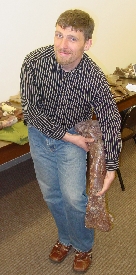Bonnan Talks About New Dinosaur Nov. 18 at Noon, Morgan Hall 109
November 16, 2009

Matt Bonnan with thigh bone.
[Download Print-Quality Image]
MACOMB, IL - - "A Sound of Distant Thunder: How a Dinosaur from South Africa Sheds Light on the Beginnings of the Giant Sauropod Dinosaurs" is the topic of a noontime Wednesday, Nov. 18 presentation in Morgan Hall 109 by Western Illinois University Associate Professor of Biology Matt Bonnan. The talk is scheduled from 12-12:50 p.m. A coffee reception will precede the talk at 11 a.m. in Morgan Hall 101A.
Bonnan has recently been in the world news as a member of the team that discovered the new Early Jurassic dinosaur from South Africa, which is described in the Nov. 11 Proceedings of the Royal Society B.
Thanks to support from National Geographic and Western Illinois University, he had been able to travel to South Africa (2004, 2006 and 2007) and work as part of the team that unearthed this new dinosaur, Aardonyx ("Earth claw"), which appears to be closely related to the common ancestor of all sauropods, he said.
While it is known the sauropod dinosaurs were gigantic, quadrupedal, long-necked herbivores that reached sizes that no other land-living animals have ever matched, the beginnings of their rise to gigantism in the Early Jurassic remain poorly understood, Bonnan added.
"In particular, it has been difficult to tell which features of their skeletal anatomy developed before or after they became giants. An analysis of the bone microstructure of the 7-meter (20 feet) long herbivore Aardonyx indicates that it was young and still growing. Its skeletal anatomy shares a number of key features with sauropods, Bonnan explained. Limb proportions show that Aardonyx was a biped, although its forearm bones interlock (like those of quadrupedal sauropods), suggesting that it could occasionally walk on all-fours. The skull and jaws show signs that this dinosaur had a wide gape and could bulk-browse, an adaptation amplified later in sauropod dinosaurs.
Despite its "small" size, sauropod-like vertebral joints had developed to brace its back bone, and the thigh bone (femur) was straightened for weight-support, he added. The feet were flattened, bore large claws and were more robust medially, features of a weight-bearing axis shifted towards the midline as in their giant near-descendants.
"The body plan of Aardonyx appears to be pre-adapted for gigantism, and, based on its position on the dinosaur family tree, it most likely approximates that of the sauropod common ancestor," Bonnan said. "Aardonyn provides significant insight into the later rise and radiation of the sauropod giants."
Posted By: University Communications (U-Communications@wiu.edu)
Office of University Communications & Marketing

Connect with us: